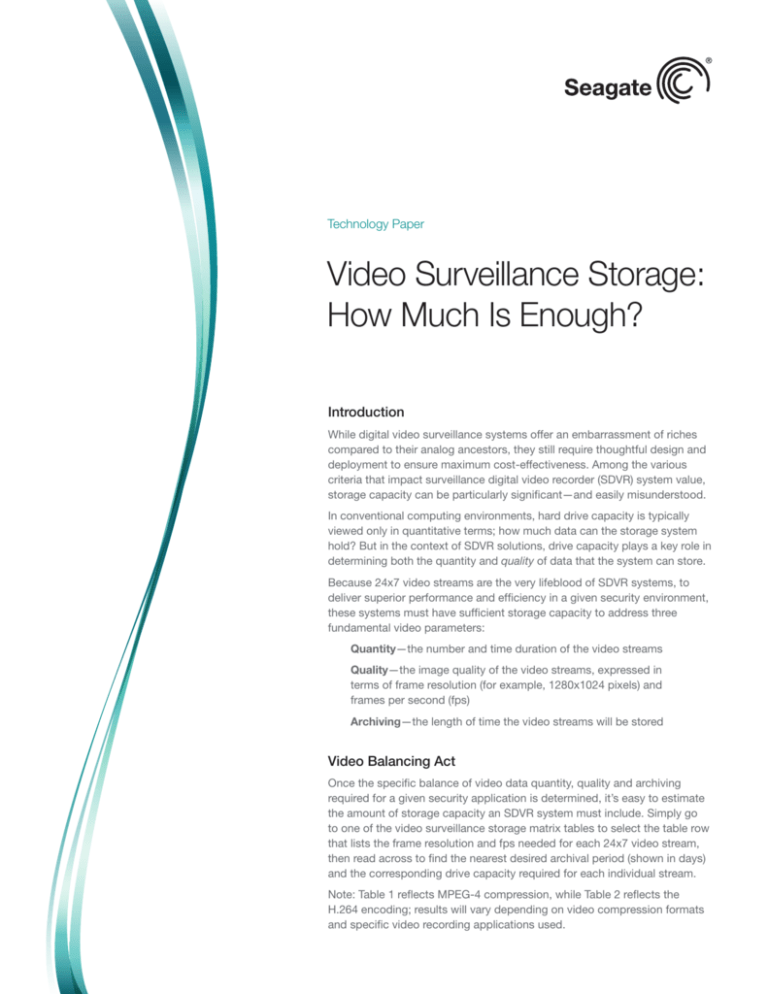
Technology Paper
Video Surveillance Storage:
How Much Is Enough?
Introduction
While digital video surveillance systems offer an embarrassment of riches
compared to their analog ancestors, they still require thoughtful design and
deployment to ensure maximum cost-effectiveness. Among the various
criteria that impact surveillance digital video recorder (SDVR) system value,
storage capacity can be particularly significant—and easily misunderstood.
In conventional computing environments, hard drive capacity is typically
viewed only in quantitative terms; how much data can the storage system
hold? But in the context of SDVR solutions, drive capacity plays a key role in
determining both the quantity and quality of data that the system can store.
Because 24x7 video streams are the very lifeblood of SDVR systems, to
deliver superior performance and efficiency in a given security environment,
these systems must have sufficient storage capacity to address three
fundamental video parameters:
Quantity—the number and time duration of the video streams
Quality—the image quality of the video streams, expressed in
terms of frame resolution (for example, 1280x1024 pixels) and
frames per second (fps)
Archiving—the length of time the video streams will be stored
Video Balancing Act
Once the specific balance of video data quantity, quality and archiving
required for a given security application is determined, it’s easy to estimate
the amount of storage capacity an SDVR system must include. Simply go
to one of the video surveillance storage matrix tables to select the table row
that lists the frame resolution and fps needed for each 24x7 video stream,
then read across to find the nearest desired archival period (shown in days)
and the corresponding drive capacity required for each individual stream.
Note: Table 1 reflects MPEG-4 compression, while Table 2 reflects the
H.264 encoding; results will vary depending on video compression formats
and specific video recording applications used.
Video Surveillance Storage:
How Much Is Enough?
Surveillance Hard Drive Capacity
NTSC: Recording Variable: 10fps
176 x 120
Low Quality
352 x 240
704 x 480
1280 x 1024
High Quality
1TB
2TB
3TB
# Days
694
1388
2082
# Days
266
532
798
# Days
86
172
258
# Days
26
52
78
Surveillance Hard Drive Capacity
NTSC: Recording Variable: 20fps
1TB
2TB
3TB
# Days
346
692
1038
352 x 240
# Days
132
264
396
704 x 480
# Days
42
84
126
# Days
12
24
36
176 x 120
1280 x 1024
Low Quality
High Quality
Surveillance Hard Drive Capacity
NTSC: Recording Variable: 30fps
176 x 120
Low Quality
# Days
1TB
2TB
3TB
230
460
690
352 x 240
# Days
88
176
264
704 x 480
# Days
28
56
84
# Days
8
16
24
1280 x 1024
High Quality
Table 1. Video Surveillance Storage Matrix (assumes MPEG-4 encoding)
Surveillance Hard Drive Capacity
NTSC: Recording Variable: 10fps
1TB
2TB
3TB
# Days
1080
2160
3240
352 x 240
# Days
414
828
1242
704 x 480
# Days
134
268
402
# Days
40
80
120
176 x 120
1280 x 1024
Low Quality
High Quality
Surveillance Hard Drive Capacity
NTSC: Recording Variable: 20fps
176 x 120
Low Quality
1TB
2TB
3TB
# Days
540
1080
1620
352 x 240
# Days
206
412
618
704 x 480
# Days
66
132
198
# Days
20
40
60
1280 x 1024
High Quality
Surveillance Hard Drive Capacity
NTSC: Recording Variable: 30fps
176 x 120
Low Quality
1TB
2TB
3TB
# Days
360
720
1080
352 x 240
# Days
138
276
414
704 x 480
# Days
44
88
132
# Days
14
28
42
1280 x 1024
High Quality
Table 2. Video Surveillance Storage Matrix (assumes H.264 encoding)
Video Surveillance Storage:
How Much Is Enough?
The tables show the enormous variation in the hard drive’s recording
capacity based on a 24x7 video stream’s resolution and frames per second.
With so many security applications entailing dozens of cameras and 24x7
video streams, it soon becomes apparent that a typical SDVR system’s
storage requirements can easily reach hundreds of gigabytes. In the
following three examples, the varying video profiles of different security
environments (and the storage capacities they require) are compared.
Example A: Extended Archiving
There are many businesses (point-of-sale and retail, restaurants, banks,
and so forth) where high-resolution, full-motion 24x7 video streams are
simply overkill. Typically employing a modest number of fixed cameras
to record customer activity, SDVR solutions in these environments are able
to employ lower image resolution and fewer frames per second while still
delivering sufficient video detail for subsequent review as needed.
When the quality of an SDVR system’s 24x7 video streams can be relatively
low, the benefits of greater HDD capacity come from enabling longer
archival storage. Archive periods can be economically extended from a
select number of days to months, or even years; indeed, continuous video
signal at 10fps/352x240 resolution can be streamed onto a 3TB drive for
798 days with MPEG-4 compression and an astounding 1242 days with
H.264 encoding (refer to Table 1 and Table 2).
Example B: Enhanced Quality
Environments with more stringent security requirements (for example,
schools, public buildings and airports) rely on 24x7 video streams
with higher resolution and more frames per second to better identify
suspicious persons and activity. Coupled with broader camera deployment,
the enhanced video quality of such streams gives security personnel a
more detailed, comprehensive view of the areas under surveillance.
Not surprisingly, the higher resolution and frame rates of such 24x7
video streams can significantly increase the capacity requirements of the
SDVR system. As shown in Table 1, just one continuous video stream at
20fps/704x480 image resolution can fill a 1TB drive in only 42 days with
MPEG-4 compression. Table 2 shows how H.264 encoding extends video
storage in this scenario to 66 days. Multiply that by the dozens of 24x7
video streams that such SDVR systems typically employ, and the need
for massive storage capacity quickly becomes clear.
AMERICAS
ASIA/PACIFIC
EUROPE, MIDDLE EAST AND AFRICA
Example C: Intelligent Video
Designed for maximum-security surveillance
environments, intelligent video takes full
advantage of the exceptional detail found in
high-resolution, full-motion (30fps) 24x7 video
streams to recognize visual patterns.
The best-known use of this technology is facial
recognition; intelligent software analyzes the
faces of persons in stored surveillance footage,
comparing their features to those of known
suspects/criminals on file. When a match is
found, the application automatically notifies
security personnel for follow-up investigation.
These high-resolution, full-motion 24x7 video
streams deliver superlative visual quality, but
do so at a price; they consume vast quantities
of storage capacity. The tables show the
voracious nature of such streams. Using MPEG4 compression, a single continuous stream at
30fps/1280x1024 resolution fully exhausts the
capacity of a 3TB drive in just 24 days, while
H.264 encoding delivers approximately 42 days
of the same quality video.
Conclusion
Boasting an unprecedented blend of visual
detail and storage capacity, digital video
recorder systems are spearheading a new era
of surveillance effectiveness and flexibility.
Purpose-built surveillance drives are key
enablers of this revolution, storing enormous
quantities of video data at remarkably low cost
per GB. The result is SDVR systems that can
seamlessly accommodate the unique image
quality and extended archival needs of modern
security environments.
www.seagate.com
Seagate Technology LLC 10200 South De Anza Boulevard, Cupertino, California 95014, United States, 408-658-1000
Seagate Singapore International Headquarters Pte. Ltd. 7000 Ang Mo Kio Avenue 5, Singapore 569877, 65-6485-3888
Seagate Technology SAS 16–18, rue du Dôme, 92100 Boulogne-Billancourt, France, 33 1-4186 10 00
© 2012 Seagate Technology LLC. All rights reserved. Printed in USA. Seagate, Seagate Technology and the Wave logo are registered trademarks of Seagate Technology LLC in the United States and/or other
countries. All other trademarks or registered trademarks are the property of their respective owners. When referring to drive capacity, one gigabyte, or GB, equals one billion bytes and one terabyte, or TB, equals one
trillion bytes. Your computer’s operating system may use a different standard of measurement and report a lower capacity. In addition, some of the listed capacity is used for formatting and other functions, and thus
will not be available for data storage. Quantitative usage examples for various applications are for illustrative purposes. Actual quantities will vary based on various factors, including file size, file format, features and
application software. Seagate reserves the right to change, without notice, product offerings or specifications. TP571.3-1202US, February 2012




